
Tahtib is the term for a traditional stick-fighting martial art originally named fan a'nazaha wa-tahtib. The original martial version of tahtib later evolved into an Egyptian folk dance with a wooden stick. It is commonly described in English as a "stick dance", "cane dance", "stick-dancing game", or as ritual mock combat accompanied by music. Nowadays, the word tahtib encompasses both martial practice and performance art. It is mainly practiced today in Upper Egypt. A Nubian form of tahtib is regularly performed for tourists in Aswan.

Beni Hasan is an ancient Egyptian cemetery site. It is located approximately 20 kilometers (12 mi) to the south of modern-day Minya in the region known as Middle Egypt, the area between Asyut and Memphis.

Minya is the capital of the Minya Governorate in Upper Egypt. It is located approximately 245 km (152 mi) south of Cairo on the western bank of the Nile River, which flows north through the city. The name of the city is derived from its ancient Egyptian name Men'at Khufu, meaning the nursing city of Khufu, linking it to the Pharaoh Khufu or Cheops, builder of the Great Pyramid at Giza.

Khnumhotep III was an ancient Egyptian high steward and vizier of the 12th Dynasty.
Percy Edward Newberry was a British Egyptologist.
The Abydos Dynasty is hypothesized to have been a short-lived local dynasty ruling over parts of Middle and Upper Egypt during the Second Intermediate Period in Ancient Egypt. The Abydos Dynasty would have been contemporaneous with the Fifteenth and Sixteenth Dynasties, from approximately 1650 to 1600 BC. It would have been based in or around Abydos and its royal necropolis might have been located at the foot of the Mountain of Anubis, a hill resembling a pyramid in the Abydene desert, close to a rock-cut tomb built for pharaoh Senusret III.

Djehutihotep was an ancient Egyptian nomarch of the fifteenth nomos of Upper Egypt during the twelfth dynasty, c. 1900 BC.
George Willoughby Fraser was an English civil engineer who operated at the service of the Egypt Exploration Fund. His parents were Sir Thomas Fraser and Matilda Wildman.
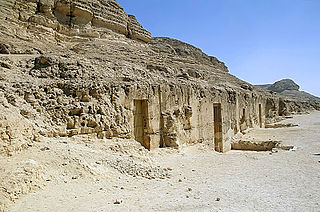
Baqet III was an ancient Egyptian official and Great Chief of the Oryx nome during the 11th Dynasty in the 21st century BCE. Apart from the position of governor of the entire nome, Baqet III also held the titles haty-a, treasurer of the king of Lower Egypt, confidential friend, true royal acquaintance, and mayor of Nekheb.
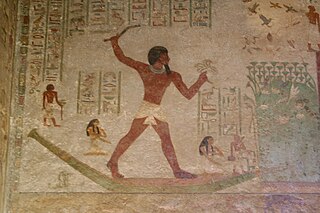
Khnumhotep II was an ancient Egyptian Great Chief of the Oryx nome during the reign of pharaohs Amenemhat II and Senusret II of the 12th Dynasty, Middle Kingdom. He is well known for his tomb at Beni Hasan and its decorations.
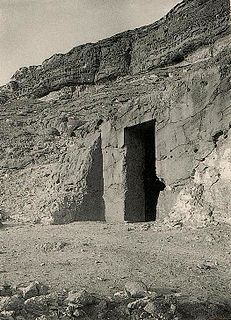
Khnumhotep I was an ancient Egyptian Great Chief of the Oryx nome during the reign of Pharaoh Amenemhat I of the 12th Dynasty, Middle Kingdom.
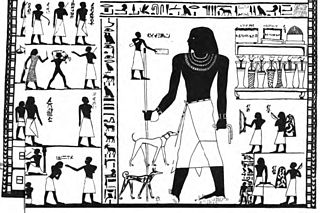
Amenemhat, often reported with his short form Ameny (Jmnjj), was an ancient Egyptian "Overlord of the Oryx nome" and chief priest during the reign of pharaoh Senusret I of the 12th Dynasty.
Herwer was an ancient Egyptian town in the 16th nome in Upper Egypt. It is mentioned in several ancient inscriptions dating from the Old, Middle and New Kingdom. The main deities of the place were Khnum and Heqet, both several times called lord or lady of Herwer. Perhaps in the Middle Kingdom, the place became capital of the 16th Upper Egyptian nome. The local governor Amenemhat of that nome was indeed overseer of the priests of Khnum of Herwer. The place is often mentioned in the tombs of Beni Hasan.

The Oryx nome was one of the 42 nomoi in ancient Egypt. More precisely, it was the 16th nome of Upper Egypt. It was named after the Scimitar oryx, and was roughly located in the territories surrounding the modern city of Minya in Middle Egypt.
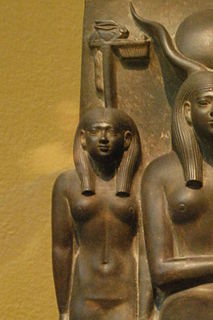
The Hare nome, also called the Hermopolite nome was one of the 42 nomoi in ancient Egypt; more precisely, it was the 15th nome of Upper Egypt.
Zatipy was an ancient Egyptian woman who lived around 2000 BC at the beginning of the 12th Dynasty under king Amenemhat I. She was the wife of Khnumhotep I who was local governor in the Oryx nome. Zatipy is depicted in the tomb of her husband at Beni Hasan. There she is shown behind him, both watching activities of peasants in the marshes. Behind her depiction, her name and titles are written. She was member of the elite (iryt-pat), wife of the ruler and lady of the house. She is also called mistress of all women. The relative high number of titles is remarkable. Especially the title member of the elite is rare for women and only better attested for women with royal connections. It was therefore proposed that Zatipy came from a royal or highly important family. If she was a princess, king Amenemhat I might have tried with this marriage to keep close ties to an important local family.

Netjernakht was an Ancient Egyptian official known from his tomb chapel at Beni Hasan in Middle Egypt. He lived most likely in the Twelfth Dynasty. His exact date and position are disputed.

Khety was an ancient Egyptian local governor of the Oryx nome in Middle Egypt in the Twelfth Dynasty. He is only known from his decorated tomb chapel at Beni Hasan. In the decoration of his tomb chapel appear several inscriptions providing the name and titles of Khety. He was great overlord of the entire Oryx nome. This is the main title of the local governors of the Oryx nome. Other titles include count (Haty-a), royal sealer, sole friend, king's acquaintance, who is in the chamber, who belongs to Nekhen and overlord of Nekheb, but also overseer of troops at all secret places. Not much is known about his family. His father was a person called Baqet, his wife was called Khnumhotep and there is one son attested with the name Khety. Naguib Kanawati wonders whether Khety was the son of Baqet III. The latter's tomb and those of Khety share the same plan and are close to each other.
Nakht was an ancient Egyptian local governor in Men'at Khufu in Middle Egypt in the Twelfth Dynasty. He is known from his decorated tomb chapel at Beni Hasan. The decoration of his tomb chapel is most likely unfinished. Only one wall is partly decorated with paintings, showing him standing in front of workers in the marshes. The inscriptions there provide the name and titles of Nakht. He was mayor and overseer of the eastern desert. Nakht is also mentioned in the tomb chapel of Khnumhotep II (BH3). In his chapel is a long biographical inscription reporting on the life of the governor but also on his family. There is stated that Khnumhotep I installed Nakht as governor in Men'at Khufu.
Nefrusy was an ancient Egyptian city which location is north of modern day cities of El Ashmunein and El Quseyya. It is known for being the site of Battle of Nefrusy between the forces of Kamose and Hyksos forces, which saw the first attested use of chariots in the history of Military of ancient Egypt. Its location has been suggested by Gaston Maspero to be at modern village of Etlidem 27 km (17 mi) south of Minya, and by Georges Daressy to be at modern village of Balansourah on the canal of Bahr Yussef 12 km (7.5 mi) west of Abu Qirqas.












